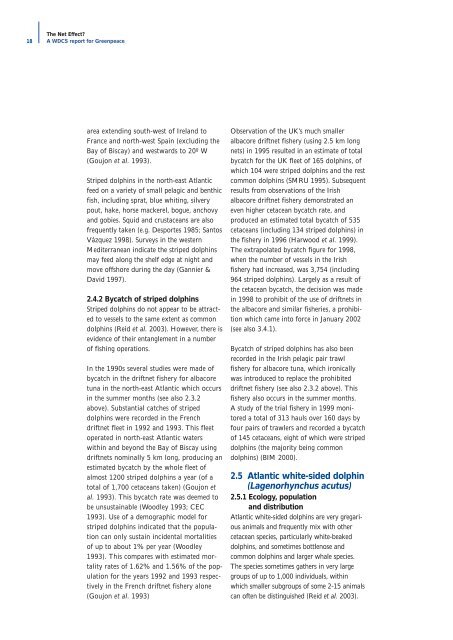The Net Effect? - Whale and Dolphin Conservation Society
The Net Effect? - Whale and Dolphin Conservation Society
The Net Effect? - Whale and Dolphin Conservation Society
Create successful ePaper yourself
Turn your PDF publications into a flip-book with our unique Google optimized e-Paper software.
18<br />
<strong>The</strong> <strong>Net</strong> <strong>Effect</strong>?<br />
A WDCS report for Greenpeace<br />
area extending south-west of Irel<strong>and</strong> to<br />
France <strong>and</strong> north-west Spain (excluding the<br />
Bay of Biscay) <strong>and</strong> westwards to 20º W<br />
(Goujon et al. 1993).<br />
Striped dolphins in the north-east Atlantic<br />
feed on a variety of small pelagic <strong>and</strong> benthic<br />
fish, including sprat, blue whiting, silvery<br />
pout, hake, horse mackerel, bogue, anchovy<br />
<strong>and</strong> gobies. Squid <strong>and</strong> crustaceans are also<br />
frequently taken (e.g. Desportes 1985; Santos<br />
Vázquez 1998). Surveys in the western<br />
Mediterranean indicate the striped dolphins<br />
may feed along the shelf edge at night <strong>and</strong><br />
move offshore during the day (Gannier &<br />
David 1997).<br />
2.4.2 Bycatch of striped dolphins<br />
Striped dolphins do not appear to be attracted<br />
to vessels to the same extent as common<br />
dolphins (Reid et al. 2003). However, there is<br />
evidence of their entanglement in a number<br />
of fishing operations.<br />
In the 1990s several studies were made of<br />
bycatch in the driftnet fishery for albacore<br />
tuna in the north-east Atlantic which occurs<br />
in the summer months (see also 2.3.2<br />
above). Substantial catches of striped<br />
dolphins were recorded in the French<br />
driftnet fleet in 1992 <strong>and</strong> 1993. This fleet<br />
operated in north-east Atlantic waters<br />
within <strong>and</strong> beyond the Bay of Biscay using<br />
driftnets nominally 5 km long, producing an<br />
estimated bycatch by the whole fleet of<br />
almost 1200 striped dolphins a year (of a<br />
total of 1,700 cetaceans taken) (Goujon et<br />
al. 1993). This bycatch rate was deemed to<br />
be unsustainable (Woodley 1993; CEC<br />
1993). Use of a demographic model for<br />
striped dolphins indicated that the population<br />
can only sustain incidental mortalities<br />
of up to about 1% per year (Woodley<br />
1993). This compares with estimated mortality<br />
rates of 1.62% <strong>and</strong> 1.56% of the population<br />
for the years 1992 <strong>and</strong> 1993 respectively<br />
in the French driftnet fishery alone<br />
(Goujon et al. 1993)<br />
Observation of the UK’s much smaller<br />
albacore driftnet fishery (using 2.5 km long<br />
nets) in 1995 resulted in an estimate of total<br />
bycatch for the UK fleet of 165 dolphins, of<br />
which 104 were striped dolphins <strong>and</strong> the rest<br />
common dolphins (SMRU 1995). Subsequent<br />
results from observations of the Irish<br />
albacore driftnet fishery demonstrated an<br />
even higher cetacean bycatch rate, <strong>and</strong><br />
produced an estimated total bycatch of 535<br />
cetaceans (including 134 striped dolphins) in<br />
the fishery in 1996 (Harwood et al. 1999).<br />
<strong>The</strong> extrapolated bycatch figure for 1998,<br />
when the number of vessels in the Irish<br />
fishery had increased, was 3,754 (including<br />
964 striped dolphins). Largely as a result of<br />
the cetacean bycatch, the decision was made<br />
in 1998 to prohibit of the use of driftnets in<br />
the albacore <strong>and</strong> similar fisheries, a prohibition<br />
which came into force in January 2002<br />
(see also 3.4.1).<br />
Bycatch of striped dolphins has also been<br />
recorded in the Irish pelagic pair trawl<br />
fishery for albacore tuna, which ironically<br />
was introduced to replace the prohibited<br />
driftnet fishery (see also 2.3.2 above). This<br />
fishery also occurs in the summer months.<br />
A study of the trial fishery in 1999 monitored<br />
a total of 313 hauls over 160 days by<br />
four pairs of trawlers <strong>and</strong> recorded a bycatch<br />
of 145 cetaceans, eight of which were striped<br />
dolphins (the majority being common<br />
dolphins) (BIM 2000).<br />
2.5 Atlantic white-sided dolphin<br />
(Lagenorhynchus acutus)<br />
2.5.1 Ecology, population<br />
<strong>and</strong> distribution<br />
Atlantic white-sided dolphins are very gregarious<br />
animals <strong>and</strong> frequently mix with other<br />
cetacean species, particularly white-beaked<br />
dolphins, <strong>and</strong> sometimes bottlenose <strong>and</strong><br />
common dolphins <strong>and</strong> larger whale species.<br />
<strong>The</strong> species sometimes gathers in very large<br />
groups of up to 1,000 individuals, within<br />
which smaller subgroups of some 2-15 animals<br />
can often be distinguished (Reid et al. 2003).

















